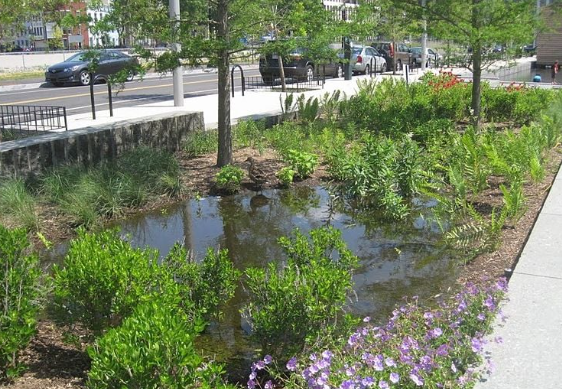A rain garden is a special garden that helps catch rainwater.
It stops water from running off your yard and into drains.
Rain gardens help keep water clean and reduce flooding.
They are easy to make and good for the environment.
What Is a Rain Garden?
A rain garden is a small, shallow garden.
It is made in a low spot in your yard.
When it rains, water flows into the garden.
The garden plants and soil soak up the water.
This stops water from running away fast.
It also helps stop pollution from reaching rivers.

Credit: www.cbc.ca

Credit: www.riversmarthomes.org
Why Build a Rain Garden?
- Stop Flooding: Rain gardens hold water and stop floods.
- Clean Water: Plants filter dirty water before it goes into rivers.
- Help Plants and Animals: Gardens give homes to bugs and birds.
- Make Yard Pretty: They add flowers and green space to your yard.
Where to Put Your Rain Garden?
Pick a low spot in your yard.
Water should flow there when it rains.
Do not build near your house’s foundation.
Stay at least 10 feet away from the building.
Make sure the spot is not too wet all the time.
How Big Should the Rain Garden Be?
Size depends on the area where water flows from.
A good size is about 20-30% of the area that drains water.
For example, if your roof is 1000 square feet, garden can be 200-300 square feet.
It does not need to be very big to work well.
Steps to Build a Rain Garden
1. Plan Your Garden
Draw a simple map of your yard.
Mark where water flows during rain.
Choose a spot that gets water easily.
2. Check The Soil
Dig a small hole about one foot deep.
Fill the hole with water and see how fast it drains.
If water drains in less than 24 hours, soil is good.
If not, you may need to add sand or gravel.
3. Mark The Garden Shape
Use a rope or spray paint to draw the garden shape.
Common shapes are round or kidney-shaped.
4. Dig The Garden
Dig a shallow hole about 6 to 12 inches deep.
Make sure the bottom is flat or gently sloped.
Use the soil you dig out to make a small mound on the lower side.
This will help hold water in the garden.
5. Add Soil Mix
Good soil helps water soak in fast.
Mix sand, compost, and garden soil together.
Use about 50% sand, 25% compost, and 25% garden soil.
Fill the garden with this mix.
6. Plant Your Garden
Choose plants that like wet and dry times.
Use native plants. They grow well and need less care.
Plant taller plants in the middle or higher spots.
Plant shorter plants on the edges.
Mix flowers, grasses, and shrubs for a nice look.
7. Mulch The Garden
Add a layer of mulch over the soil.
Mulch keeps soil moist and stops weeds.
Use shredded bark or wood chips.
Put about 2-3 inches of mulch.
8. Water The Garden
Water the plants well after planting.
Keep watering every few days for the first few weeks.
After plants grow, rain will water them mostly.
Good Plants for Rain Gardens
Choose plants that handle wet and dry weather.
Here are some easy plants to use:
| Plant Name | Type | Special Notes |
|---|---|---|
| Blue Flag Iris | Flower | Likes wet soil, adds color |
| Switchgrass | Grass | Grows tall, helps soil stay strong |
| Black-eyed Susan | Flower | Bright yellow flowers, easy to grow |
| Redtwig Dogwood | Shrub | Has red stems, good for winter |
| Joe-Pye Weed | Flower | Attracts butterflies and bees |
How to Care for Your Rain Garden
- Water: Water new plants until they grow strong.
- Weed: Remove weeds to help plants grow well.
- Mulch: Add mulch yearly to keep soil healthy.
- Check Drainage: Make sure water flows well after rain.
- Replace Plants: If some plants die, plant new ones.
Benefits of a Rain Garden
Rain gardens help the planet and your home.
They keep water clean by stopping dirt and chemicals.
They reduce flooding by holding rainwater.
They create homes for birds, bees, and butterflies.
They make your yard look beautiful all year.
Common Mistakes to Avoid
- Building too close to your house can cause water problems.
- Choosing plants that do not like wet soil.
- Making the garden too deep or too flat.
- Not checking soil drainage before building.
- Forgetting to water plants after planting.
Frequently Asked Questions
What Is A Rain Garden?
A rain garden is a shallow, planted depression. It absorbs rainwater runoff from roofs, driveways, and patios.
Why Build A Rain Garden?
Rain gardens reduce runoff, filter pollutants, and provide habitat for wildlife. They also enhance landscape beauty.
How Does A Rain Garden Work?
It captures and absorbs rainwater. Plants and soil filter pollutants, allowing clean water to seep into the ground.
What Plants Are Best For Rain Gardens?
Native plants work best. They are adapted to local climate and soil, supporting local wildlife.
Conclusion
Building a rain garden is a smart and simple way to help nature.
It helps stop floods and keeps water clean.
You do not need a big yard or special tools.
With some planning and work, you can make your own garden.
Your rain garden will help plants, animals, and people.
Start today and see the difference it makes!
5 min read

